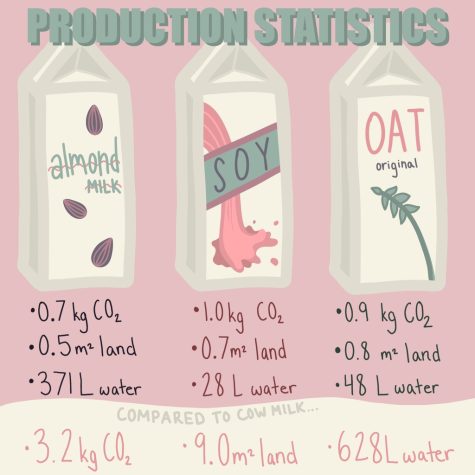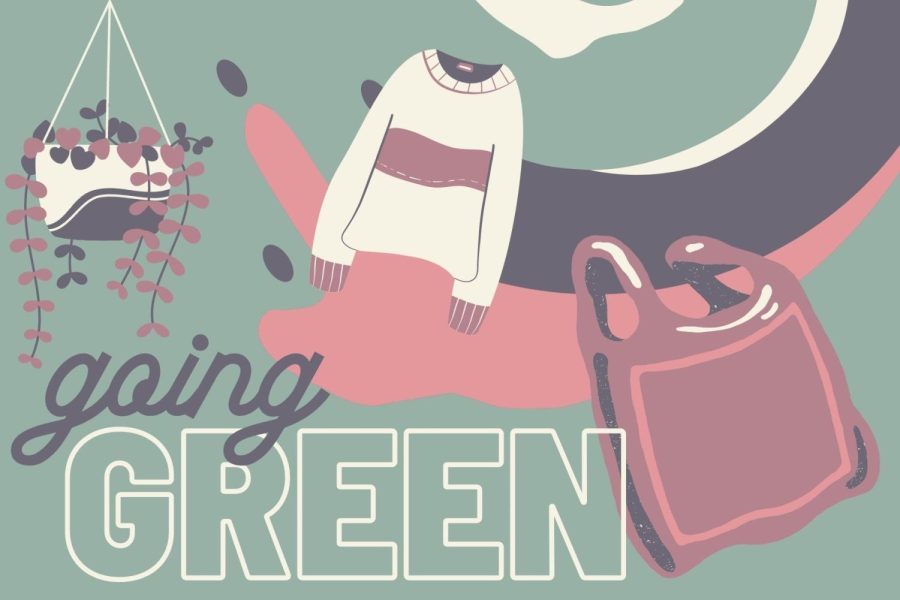We’ve all heard the classics. “Turn the lights off when you leave the room. Don’t leave the water running while you brush your teeth. Recycle paper instead of throwing it away.” These are all small changes we can make in our daily lives to become more sustainable. But what about those who want to take it a step further?
Large sustainable changes may seem impossibly out of reach for busy students with little money. For example, expensive sustainable clothing brands and solar panels aren’t typically in the realm of possibility for a high school student. Large changes aren’t the final word in sustainability; there are still many real changes that students can make to their lives.
Reuse

Large companies push consumers to buy their modern tan and green products with slick packaging and “all-natural” labels. The eco-friendly aesthetic of buying greenwashed products is an enticing lifestyle that many become trapped into. However, the most sustainable option is to reuse what you already have.
Throwing out functioning, unsustainable products can be counterintuitive to make room for new, sustainable products. At the end of the day, it’s more important to use our possessions until they can no longer be used, which reduces pointless waste.
Along with reusing household items, thrift stores are a great option for when old clothes no longer fit. Thrifting is a relatively cheap, convenient option for those looking to be more sustainable. Many students enjoy thrifting and repurposing clothes that would have otherwise gone to waste. Junior Olivia Davis works at Uptown Cheapskate, a thrift store that buys and sells used clothes.
“I love the idea of thrifting. It’s a really cool concept because you get to find things in stores that you wouldn’t find. They’re things that people have already picked, so then you get to see all the best of the things that people have already picked,” Davis said. “It’s really good for people and for the environment.”
Choose sustainable alternatives

Even small choices such as changing the products we invest in can add up to significant differences. For instance, animal products, plastic grocery bags and disposable water bottles are all common, everyday items in many people’s lives. Choosing alternatives to these items reduces the amount of waste we contribute to the environment.
Instead of opting for plastic grocery bags with every shopping trip, invest in a few large reusable bags. Additionally, if using plastic bags is unavoidable, the bags can still be saved and used in home trash cans or for various other things.
For those hoping to become even more environmentally conscious, cutting down on meat or dairy is a viable option. Of course, dietary restrictions can prevent people from becoming vegetarian or vegan. But for those who have the ability and finances to do so, reducing animal product consumption is one of the best ways to live sustainably.
“I’ve always been interested in being eco-friendly and trying to help the environment more. [Being vegetarian] is one of the best things an individual can do for the environment. That is, in my opinion, the number one thing you can do to change the environment as just one person,” junior Quinn Gillies said.
Educate
One of the easiest yet commonly overlooked ways to be sustainable is simply educating ourselves about climate change and the environment and informing others. This can be done through reading books, learning from experts and doing research. Often, blame is put on consumers rather than large companies. However, just 100 companies create 71% of global emissions through pollution. In addition, other fast fashion and food companies encourage consumers to buy unsustainable products.
“We hear about global warming and ‘the world’s going to end,’ and that’s inevitable, but putting it off for as long as possible seems like a good idea,” senior Shruti Panda said. “It doesn’t affect me directly, but there’s a lot of people who would be affected a lot worse by global warming than any of us would. Being sustainable reduces the impact [of climate change] for them in the future. So at least there’s a chance that it will, and that’s worth trying for.”
People can look into and participate in many aspects of sustainability. For example, many environmental groups are open for citizens to help clean up local areas and participate in various initiatives. Additionally, conversations about sustainability can range from veganism to non-renewable resources to environmental justice and poverty.
“If we overuse the materials and natural resources on Earth, there’s not going to be anything left. So sustainability would help us be more sufficient in what we already have and not make [global warming] harder for future generations to deal with,” senior Esther Ji said.
There’s an abundance of resources available at our fingertips to learn more about the environment. Senior Linh Luong takes an environmental engineering course offered to students to learn more about the environment.
“We take so many things for granted and do not know how much we are harming the environment, yet we depend on it. If we aren’t educated about it, we could harm it to the point of no return,” Luong said. “You don’t need to change what you do on a daily basis dramatically. Just start slowly and build up from there.”





![There are more than 20 open cardio machines at Crunch Fitness. I enjoyed the spacious environment at Crunch, a sentiment that was shared by sophomore Sanjana Daggubati. “[Going to] Crunch Fitness was the right decision because [it] feels more professional. Crunch’s workers are laid back, but not to the point where they don't care,” Daggubati said.](https://pwestpathfinder.com/wp-content/uploads/2025/09/IMG_5242-1-1200x900.jpg)

![Various empty Kit Kat wrappers crowd the desk, surrounded by scoring sheets. While production of Kit Kat flavors in the U.S. is limited, Nestlé, the owner of Kit Kat, manufactures hundreds of unique flavors in Japan, including the flavors ocean salt and passion fruit. “I thought there [were] some interesting flavors, and a lot of them were really unexpected,” senior Elle Levesque said.](https://pwestpathfinder.com/wp-content/uploads/2025/09/image-2.png)


![Pantone’s selection of the 2025 Color of the Year is revealed: Mocha Mousse. Ceramics teacher Ashley Drissell enjoys this year’s selection. “Maybe it’s the name but [Mocha Mousse] reminds me of chocolate and coffee. It makes me hungry. It’s very rich and decadent,” Drissell said.](https://pwestpathfinder.com/wp-content/uploads/2025/02/DSC_0015-1200x800.jpg)




Emily • Apr 8, 2022 at 4:47 pm
Great story, Addie! Love the graphics!